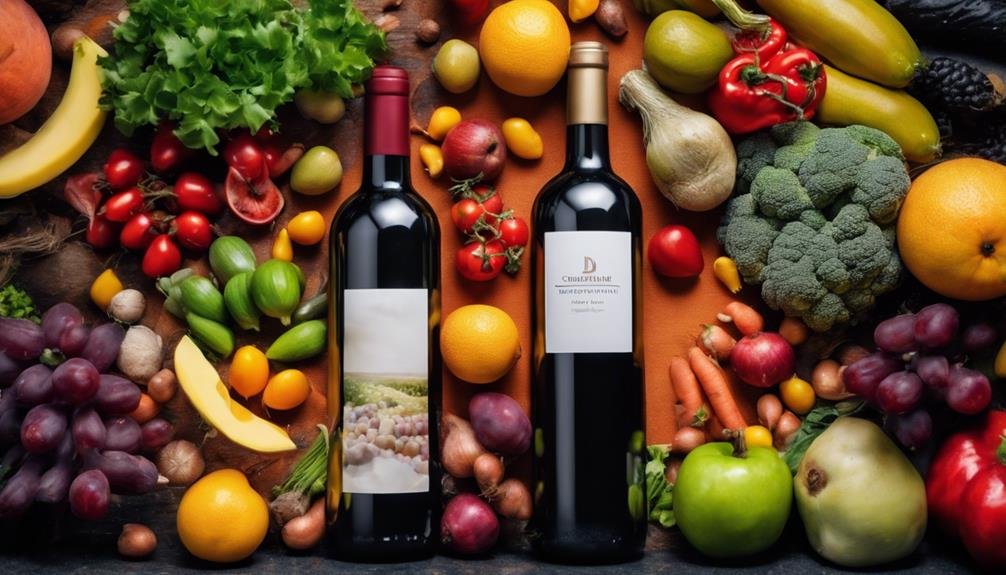Exploring wine additives unravels a world where flavors, colors, and textures harmonize to craft each glass. They guarantee aroma, color, and texture meet desired standards, creating a balanced end product. Regulations govern these additions, ensuring compliance and safety. Vegetarian and non-vegetarian options vary, impacting production choices. Acid control techniques play an essential role in taste and stability. Beware of health effects like allergies and headaches from certain additives. Opt for organic wines and educate yourself on labels for a more informed choice. Discover the intricate secrets that shape every sip of wine.
Wine Additives and Their Functions
Commonly used in winemaking, additives play essential roles in shaping the flavor, structure, and aging potential of wines.
Flavor enhancement is achieved through the use of additives that help intensify the taste profile, while aroma preservation guarantees the retention of the wine's aromatic qualities.
Color intensification is another function of additives, enhancing the visual appeal of the wine, while texture improvement contributes to the overall mouthfeel and body of the beverage.
By carefully selecting and incorporating additives, winemakers can create a balanced and harmonious final product that appeals to consumers' senses.
Understanding the functions of these additives is pivotal in the art of winemaking, as they contribute significantly to the quality and character of the wine.
Regulations and Monitoring Practices
Regulations and monitoring practices in the wine industry guarantee the safe and controlled use of additives throughout the winemaking process.
- National regulatory bodies oversee the approval and monitoring of additives.
- Compliance checks ensure adherence to permitted additive lists.
- Regular inspections of wineries are conducted to monitor compliance.
- Regulatory oversight aims to maintain the integrity and quality of wines.
Monitoring compliance and regulatory oversight are essential components of ensuring that additives used in winemaking meet safety standards and regulatory requirements. By enforcing strict guidelines and conducting regular checks, authorities aim to uphold the reputation of the industry and protect consumer interests.
Vegetarian and Non-Vegetarian Additives

An exploration of the presence of vegetarian and non-vegetarian additives in winemaking reveals the diverse range of ingredients utilized in the production process. Non-vegetarian additives such as albumen, milk products, and isinglass are commonly used, along with gelatin and protease from animals. Vegetarian alternatives like advanced microbial products are available as modern substitutes to traditional methods. Egg whites and traditional techniques are still in use, while casein and potassium salt of casein aid in clarification. The table below provides a concise summary of vegetarian and non-vegetarian additives in winemaking:
| Additives | Vegetarian Options | Non-Vegetarian Options |
|---|---|---|
| Albumen | Advanced microbial products | Gelatin |
| Milk Products | Egg whites | Protease from animals |
| Isinglass | Traditional methods | Casein |
Acid Control and Stabilization Techniques
Utilizing various methods to control acidity and guarantee stability in wine production is essential for maintaining quality and consistency in the final product. To achieve this, the following techniques are commonly employed:
- pH Balance: Monitoring and adjusting the pH levels are important for achieving desired taste profiles and ensuring the proper aging potential of the wine.
- Stabilization Methods: Stabilizers such as acetaldehyde and DMDC are used to maintain the wine's consistency throughout production and storage.
- Acid Adjustments: Calcium carbonate can be used to reduce high acid levels, while tartaric, malic, and citric acids help balance acidity levels in the wine.
- De-acidification: Acidifiers and de-acidifiers play a significant role in fine-tuning and adjusting the acidity of the wine to meet specific quality standards.
Health Impact and Consumer Awareness

With growing consumer interest in wine production practices and their potential health impacts, it is important to explore the additives used in winemaking and their implications on consumers' well-being.
Sulfites, commonly found in wines, can trigger allergic reactions in sensitive individuals. Histamines present in wine have been linked to headaches in some people. Additionally, certain additives used in winemaking can disrupt gut bacteria balance, potentially leading to migraines.
To mitigate these risks, consumers are encouraged to opt for organic wines that contain fewer additives. It is advisable to educate oneself on common wine additives, check labels for ingredient lists, and support natural winemakers who prioritize minimal intervention in the winemaking process.
Frequently Asked Questions
Are There Any Natural Alternatives to Common Wine Additives?
Natural alternatives to common wine additives involve sustainable practices like using advanced microbial products instead of animal-derived fining agents. Winemakers increasingly opt for organic methods, avoiding synthetic additives, to cater to consumer demand for healthier, more natural wine options.
How Do Wine Additives Affect the Environment?
Like a double-edged sword, wine additives wield environmental impact. Sustainability practices can mitigate harm. Consider the carbon footprint, waste generation, and resource consumption. Embrace eco-friendly choices to preserve our vineyard landscapes for future generations.
Can Wine Additives Influence the Taste of the Final Product?
Wine additives play an important role in shaping the flavor profile and sensory evaluation of the final product. By influencing the chemical composition during the fermentation process, additives like sulfur, tannins, and acids can enhance or alter the taste significantly.
Do Different Wine Regions Have Specific Rules on Additives?
Different wine regions have specific rules on additives, governed by additive regulations and regional restrictions. For instance, the EU enforces strict regulations, while the US permits over 60 different additives. Understanding these rules is essential for winemakers.
Are There Any Additives That Can Enhance Wine Aging Potential?
Certain additives can enhance wine aging potential by acting as preservatives and imparting antioxidant properties. Substances like sulfur, tannins, and certain stabilizers contribute to flavor complexity and help maintain the wine's integrity over time, promoting enhanced aging benefits.
Conclusion
To sum up, the world of wine additives is a complex and regulated one, with various substances serving specific functions in shaping the final product.
It is important for consumers to be aware of the additives used in winemaking and their potential impact on health.
Studies have shown that over 60% of wines on the market contain some form of additives, underscoring the pervasive nature of these substances in the industry.